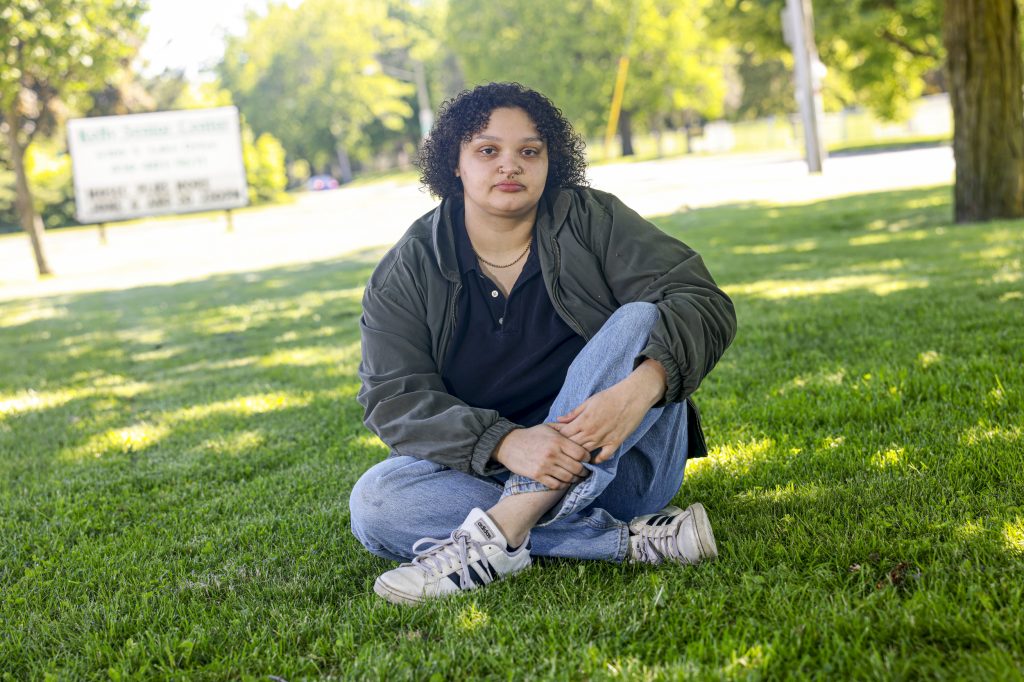360,000 in Wisconsin Lose Health Insurance Amid Medicaid Changes
About 30% of recipients up for renewal face disenrollment, most due to procedural issues.

Teresa, a Dane County mom who asked to be identified by her middle name, was one of six Wisconsin residents who shared their experiences with what’s called the “unwinding” of Medicaid: the restart a year ago of income checks and other recertification after a three-year pause. (Steve Apps for Wisconsin Watch)
This story was originally published by Wisconsin Watch, WPR and Isthmus.
Teresa was used to paying just $6 for medication to treat a chronic condition that puts her at high risk for a stroke and heart attack. So the Dane County resident was shocked this spring when the pharmacy cashier asked for more than $1,000 — more than some of her paychecks.
She sprung into action by calling the Capital Consortium, which determines Medicaid eligibility for residents of Dane and seven other counties. After two disconnections and 35 minutes on hold, a benefits specialist told her that she made $20 to $30 a month too much to qualify for BadgerCare Plus, Teresa recalled. The specialist considered only her two most recent months of pay, rather than summer months, when her income dips as work slows down, Teresa recalled.
The loss of coverage left her consumed by anxiety.
“I’m a single mom. That’s the number one thing that goes through my mind,” said Teresa, who asked to be identified by her middle name for fear her employer would retaliate if she discussed her employment. One of her two children has a disability and depends on her for regular assistance.
Teresa was one of six Wisconsin residents who shared their experiences with what’s called the “unwinding” of Medicaid: the restart a year ago of income checks and other recertification after a three-year pause.
Four of those residents were among more than 360,000 in Wisconsin who lost coverage during unwinding, according to Wisconsin Department of Health Services data. Two others described a frustrating recertification process.
Medicaid provides health insurance to low-income households. In Wisconsin that includes programs like BadgerCare Plus, which serves children, pregnant people and non-disabled adults, and long-term care programs for people with disabilities and seniors.
The federal government requires states each year to verify Medicaid recipients’ eligibility, but it paused the mandate early in the pandemic to help people maintain coverage. Verification resumed in June 2023 in Wisconsin. As of this month, all Wisconsin Medicaid recipients should have submitted their first renewal application during the restart.
Wisconsin’s Medicaid population has shrunk 18% during unwinding, the 13th sharpest percentage decline among states, according to an analysis by the health policy research firm KFF.
Wisconsin took advantage of relatively few strategies suggested by the federal government to keep more people enrolled, making adjustments only after more than 560,000 renewal deadlines passed.
The Legislature’s Republican-controlled budget writing committee in 2023 rejected a proposal by Democratic Gov. Tony Evers to lift the income threshold for Medicaid, funded mostly with federal pandemic relief. Just nine additional states have refused federal incentives to expand access.
“As the last several months have demonstrated, states’ choices have real consequences for people’s ability to stay enrolled,” a federal Centers for Medicare and Medicaid Services spokesperson said in an email.
A frustrating renewal process
Teresa’s Medicaid renewal notice arrived in the mail early in 2024, languishing for months in a to-do pile while she focused on other urgent tasks, including work and assisting her child. Filling out the multi-page form required energy she didn’t have.
“I’m just overwhelmed on a daily basis,” Teresa said.
Three years without Medicaid renewals during the pandemic meant a bit less medical paperwork for Amanda Upton, a mom of two children with disabilities in Racine County.
And now that renewals are back, “it’s one more thing that has to live in my head,” said Upton, who is waiting for a determination in the mail after sending in the forms in January.
“Every morning I look to see, hopefully that letter is coming to let us know, determination,” Upton said.

Teresa, a Dane County mom, lost Medicaid coverage this year after being told she earned $20 to $30 too much each month to qualify. She’s among more than 360,000 Wisconsin residents who lost coverage so far during the “unwinding” of Medicaid. Teresa asked to be identified by her middle name for fear her employer would retaliate if she discussed her employment. (Steve Apps for Wisconsin Watch)
Some states have done more than Wisconsin to minimize bureaucratic hurdles, including at least 12 that used available databases to determine eligibility for 50% or more of renewals processed so far — what some call passive review.
Wisconsin passively reviewed just 27.5% of all renewals through April, but its monthly rate is increasing — from 8% in early months to 45% most recently, the state health department said.
The federal agency suggested more than two dozen temporary procedures for states to minimize enrollment cuts during unwinding. Wisconsin received waivers for just two, with only South Dakota and Florida enrolling in fewer.
Passive review is among the biggest factors shaping state disenrollment rates — especially for children, said Allexa Gardner, a research fellow at Georgetown’s Center for Children and Families.
Wisconsin children qualify for Medicaid in households earning up to three times the federal poverty level. That’s three times higher than the threshold for parents or caregivers to qualify for coverage.
Parents who earn too much to stay covered might assume their kids don’t qualify either and ignore renewal paperwork, Gardner said. States with more robust passive review minimize parental confusion, increasing the likelihood that kids stay enrolled, Gardner said.
Wisconsin saw the 16th sharpest decline in child Medicaid enrollment among states since the start of unwinding, according to a Georgetown analysis.
The state’s automated renewal system initially disenrolled 4,000 eligible recipients, including children, in the first months of unwinding. Wisconsin, one of at least 30 states at the time reporting passive review errors, disenrolled entire households rather than examining individuals.
The state implemented several changes in December to improve the system, Goodsitt said.
Medicaid rolls still higher than before the pandemic
Despite coverage cuts during unwinding, Wisconsin, like most states, still enrolls more people now than it did before COVID-19: about 1.37 million people as of April, up from an average of 1.2 million.
When millions of people lost their jobs — and health coverage — early in the pandemic, states increased messaging about signing up for Medicaid to meet the growing need. That prompted a flurry of sign-ups from people who were eligible before the pandemic but didn’t enroll, Gardner said.
While Wisconsin’s statewide enrollment remains 15% above pre-pandemic levels during unwinding, the growth is uneven across counties.
Milwaukee County’s enrollment jumped the lowest during that period at just 10%. The biggest gains were reported by county consortiums led by Dane and Fond du Lac counties, which each have seen enrollment increase 22% since before the pandemic.
Living in Dane County didn’t help Codie Peschl, who this year lost Medicaid coverage she had relied on for 17 years.
The mother of three and full-time home health caregiver makes $17.50 an hour. That’s well below the threshold to keep coverage for her kids but $433 too much a month to qualify for her own Medicaid coverage.
Wisconsin’s Republican lawmakers have long declined to accept federal funds to broaden Medicaid eligibility, including in 2023 when the federal government offered additional incentives through pandemic relief.
They have argued that expanding Medicaid would increase private insurance costs and burden future taxpayers. They point out that of the 10 states that haven’t expanded Medicaid, Wisconsin is the only one without what some call a coverage gap.
That’s because the state’s Medicaid program covers low-income adults making up to the federal poverty level — the same point at which they qualify for subsidized plans on the federal Health Insurance Marketplace. It’s one reason Republican lawmakers called a 2021 expansion proposal “unneeded and even reckless.”
Evers’ latest proposal would have allowed households earning up to 138% of the poverty level to qualify for Medicaid. Had that become law, Peschl would still qualify.
She’s going without coverage since losing BadgerCare Plus in February, leaving a broken tooth and intense nerve pain untreated.
“It’s hard to sleep sometimes because it’s just so painful and irritating,” Peschl said.
She likely qualifies for subsidized marketplace plans but still worries about the cost.
Raising three sons on her income is a struggle, Peschl said. “Do I want to pay for health care or do I want to feed them?”
Some booted from Medicaid go without coverage
Wisconsin saw a 20% surge in marketplace enrollment between 2023 and January 2024 — largely driven by Medicaid unwinding and better marketing, according to KFF analyses.
But marketplace plans can require out-of-pocket costs and cover less than Medicaid.
In some cases, out-of-state insurance brokers encourage former Medicaid recipients to pay for plans they don’t qualify for — perhaps because of their immigration status — or plans with network providers based hours away, said Francisco Guerrero, a health navigator for Covering Wisconsin, a University of Wisconsin-Madison Extension program.
Some who lose Medicaid are avoiding the marketplace.
After Wisconsin lowered Medicaid income limits for parents and caregivers in 2014, just a third of those who lost coverage successfully transitioned to private insurance within two years, a 2022 Journal of Health Politics, Policy and Law article found.

Caitlyn McGeary, 25, lost Medicaid in July 2023 and lacked coverage for several months. Today, the Cudahy, Wisconsin, resident gets insurance through their employer after finding a new job. But they say they’re still paying for medical care they received while uninsured. (Jeffrey Phelps for Wisconsin Watch)
In the Milwaukee suburb of Cudahy, Caitlyn McGeary, 25, says switching to a marketplace plan after losing BadgerCare Plus could have added $200 per month in costs. After relying on Medicaid since childhood, they started earning too much at their Walmart job to qualify.
McGeary was denied recertification last July and felt a creeping dread in the weeks before losing coverage. They stopped scheduling appointments and therapy sessions.
Teresa had a marketplace plan before switching to BadgerCare Plus at the start of the pandemic. She struggled to afford the monthly payments when her work slowed.
“They kept billing me and billing me and billing me,” Teresa said. “So this time, I decided I’m not going to put myself through that again.”
Teresa doesn’t want to leave the doctor and nurse she’s worked with for five years, which switching plans might have required.
Turning to free clinics
Teresa got COVID-19 after losing BadgerCare Plus. As she struggled to breathe for two days, she wondered: “What if I have to go to the emergency room? How am I going to afford something like that?”
A free clinic prescribed an inhaler that eased the worst of her symptoms.
Free clinics lack the resources to care for everyone who lost Medicaid, said Jeffrey Todd, manager of the First Presbyterian Church of Wausau’s free clinic, which has seen 60 to 70 extra patients per month over the past year and a half.
He’s not sure whether the extra activity is related to unwinding, the clinic’s new facility or something else. But the workload isn’t sustainable, he said.
To Teresa, living without health insurance doesn’t seem sustainable either.
Her doctor has prescribed a cheaper medication to manage her chronic condition and lower her risk of stroke and heart attack. It’s not as effective as the prescription she can no longer afford, and it’s taking a toll on her health.
“It’s extremely scary,” Teresa said. “And all I can think about are my kids.”
Addie Costello is WPR’s Mike Simonson Memorial Investigative Reporting Fellow embedded in the newsroom of Wisconsin Watch.




















WWJD?